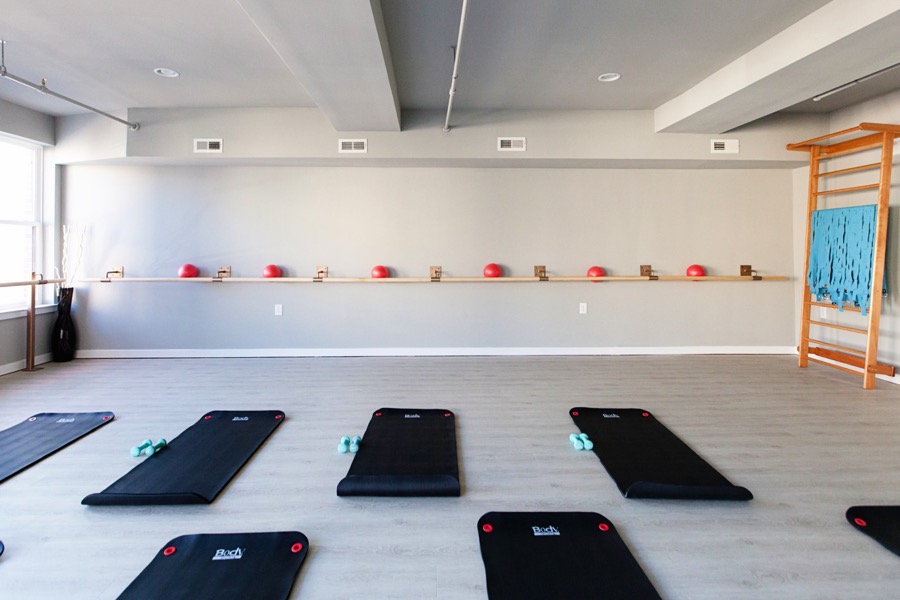7 Common Mistakes You’re Probably Making in Barre Classes
Barre classes can get technical — here's how to avoid typical pitfalls.

Photo courtesy of The Wall Cycling Studio.
Let’s get real for a sec: It is super easy to make mistakes in fitness classes. If you aren’t already a pro at whatever group fitness class your taking — like barre, for example — trying to emulate the teachers moves, while simultaneously trying to keep up with the class can prove to be quite the feat that might result in bad form and, worst case, injury.
To save you from all the potential barre mistakes — which, honestly, can be abundant in this fairly technical Pilates-yoga-ballet-fusion workout — we reached out to a bunch of local barre pros and asked them to spill the most common mistakes they see in their classes, plus how to fix them. Read on to ensure that you’re getting the most out of your barre classes — whether you’re a total newbie or seasoned pro — and chances are, your muscles will thank you.
The Mistake: Making the movement too large
The Fix: “Make the range smaller! A small one- to two-inch movement is the proven range that will most efficiently and safely change the shape of your muscles, while keeping your joints safe. Isometric exercises allow students to stay “in the muscles” that are being worked and will create a leaner, stronger physique.” — Gina Russo, The Bar Method. Pure Barre’s Noelle Zane adds: “The goal is to ‘find your shake’ in each position, but if the movement becomes too large, we lose proper form and momentum takes over, and you’ll lose out on the shake. Focus on keeping movements small, tight, and controlled — sometimes you’ll look in the mirror and see barely any movement at all, but most likely the squeezing, shaking and burning will be at its finest. Embrace the burn.”
The Mistake: Sinking super low in your sumo squat
The Fix: “Lower isn’t always better when it comes to your sumo squat. Instead, focus on what is working — your glutes! To perfect your sumo squat, step your feet out a touch wider than your hips with your toes slightly turned out (think 11 and 1 on an imaginary clock). Then, sink your seat back as if you were reaching for a chair behind you. In order to engage your glutes, dig down through your heels and the second you feel a catch in the base of your seat, stop there! Then, scan your upper body. Your chest should be lifted so your gaze naturally looks out on the horizon. While holding this position, the work lives in your heels. So, the more you push your heels, the more your glutes will be engaged. Hello, peach emoji!” — Stephanie Grimes, Barre3.
The Mistake: Improper shoulder and hip alignment — shoulders crunched up and pelvis sticking out — in chair position
The Fix: Your body should mimic what a chair looks like — all right angles. Keep your ears over shoulders, shoulders over hips, hips over knees and knees over heels. To align the shoulder and hips, roll the shoulders back and pull you hips forward. Feel as if your hips are pulling up towards your chin.” — Juliet Sabella, The Wall Cycling Studio.
The Mistake: Not taking advantage of the stretches during class
The Fix: “Stretching plays a significant role in changing the shape of your muscles. The Bar Method places stretch sequences at precise times during class to allow muscles to strengthen, taper and elongate in the safest and most efficient way. Flexible muscles will result in a leaner, more graceful body and will enhance the results that you get from a barre class.” — Gina Russo, The Bar Method.
The Mistake: Improper foot positioning
The Fix: “Proper foot and toe positioning is the difference between really working a specific muscle group and not working that muscle group. Depending on the barre move you are doing, your feet will usually be facing parallel — at 12 o’clock — or be two to three inches apart — between 11 and 1 o’clock. Because of how the body aligns, feet being too wide can cause hip strain and feet being too narrow can cause knee strain.” — Juliet Sabella, The Wall Cycling Studio.
The Mistake: Over-rotation during oblique work
The Fix: “While working the obliques in our abs section, it isn’t about twisting as far to one side as you can. Rather, you want to focus on keeping your chest straddling your thigh and work from there. To deepen the move, re-tuck your hips, get lower, keep the feet pressing down and the movement and twists teeny-tiny. Think of the movement stemming from the abs — the arms and shoulders just follow. This awareness will keep your position and form on point and you’ll be able to delve into your best oblique work.” — Noelle Zane, Pure Barre.
The Mistake: Thinking barre is not a cardio workout
The Fix: “A barre workout is fast-paced and challenges both your cardiovascular system and muscle strength. The intensity of the workout drives your body to burn calories throughout class as well as for several hours after. Barre classes are a form of interval training that build stamina and burn calories.” — Gina Russo, The Bar Method.
And don’t forget, my barre-loving friends, that all fitness instructors love when you ask questions so, don’t be shy — they want you have the best experience possible.
Like what you’re reading? Stay in touch with Be Well Philly—here’s how:
- Like Be Well Philly on Facebook
- Follow Be Well Philly on Instagram
- Get the Be Well Philly Newsletter
- Follow Be Well Philly on Twitter


